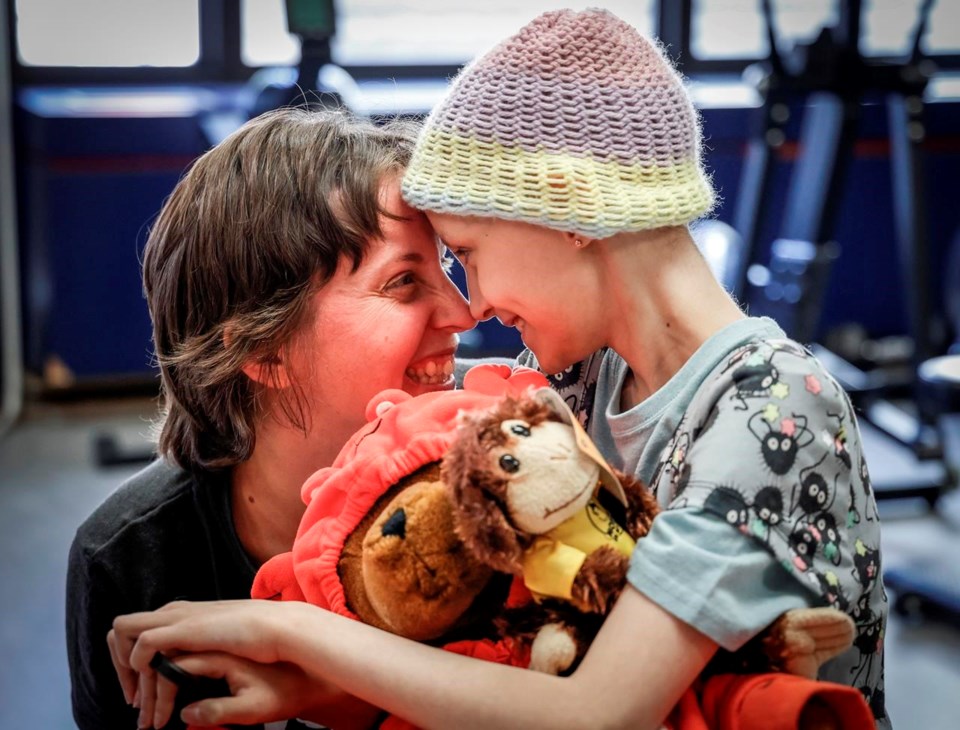CALGARY — It's been a challenging time for Mira Penney.
The 10-year-old was diagnosed with a brain tumour, had it removed in August of last year and then underwent a round of chemotherapy. An infection left her hospitalized for three months and some days she didn't want to get out of bed.
But Mira was all smiles this week as she took part in a University of Calgary study looking into the effect of physical activity for young people with cancer.
Although the program is normally online, she met in person this week with her exercise buddy, PhD student Emma McLaughlin.
Playing games like "pass the stuffie" using her friend Bear Bear, sitting in a chair lifting her legs or standing on one leg and then the other made physical activity fun.
"I think part of it is the stuffies. It depends on the day, because we always go according to how I'm feeling, which is why I really like it," said Mira, wearing a pink, light blue and yellow tuque she knitted herself.
"Sometimes we'll do passing-the-stuffie, which Mom has to help me with, and sometimes we'll lift it up or catch it depending on the size. I think it's just doing it and knowing that I can do it. That's the most rewarding."
Children often become inactive during treatment and there are currently no formalized exercise programs to support them.
Mira is one of six children taking part in the program at the University of Calgary's Health and Wellness Lab.
It involves individualized exercise programs for any child or adolescent with cancer or blood disease receiving treatment, or recently having been treated, in Alberta.
Bridget Penney, Mira's mother, said she has noticed a difference compared to when her daughter began the program last November.
"She wasn't moving. She wasn't doing a whole lot of anything. There were definitely days she was just not feeling up for anything," she said.
"Then it would be one of those days where we'd have a session and she'd be like 'Mom, I don't think I can do this' and she'd go out and we'd log on and she'd see (McLaughlin's) face and she'd say 'Maybe I can do one exercise. Maybe I'll do two.'"
McLaughlin said it's been gratifying to work with Mira over Zoom.
"I think what's fun is no matter what I do, we're still able to form these amazing connections," she said.
"We do tailor it each day based on the abilities and how the kids are feeling. Some days, that may be sitting in a chair or lying in bed. It's really driven by the kids."
Study lead Nicole Culos-Reed, a professor in the faculty of kinesiology, would like to see the exercise program included in children's clinical care.
"There's this huge gap. If you watch children, they run and play. Yet, when we see children affected by a chronic disease like cancer, they're all of a sudden sedentary and we know we can use exercise as an evidence-based intervention to really enhance their well-being overall," Culos-Reed said.
"We know that exercise is really great for some of the different issues that these children might face … things like fatigue, things like pain, things like feeling they can't do something anymore. This gives them back that opportunity to feel better and be more in control."
The study team at the Alberta Children's Hospital in Calgary and Children's Hospital in Edmonton has plans to expand across Canada.
This report by The Canadian Press was first published Sept. 13, 2023.
Bill Graveland, The Canadian Press




